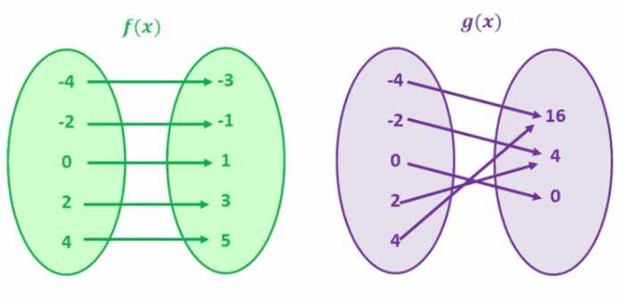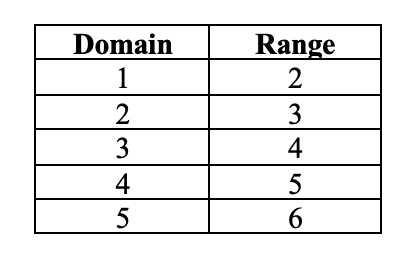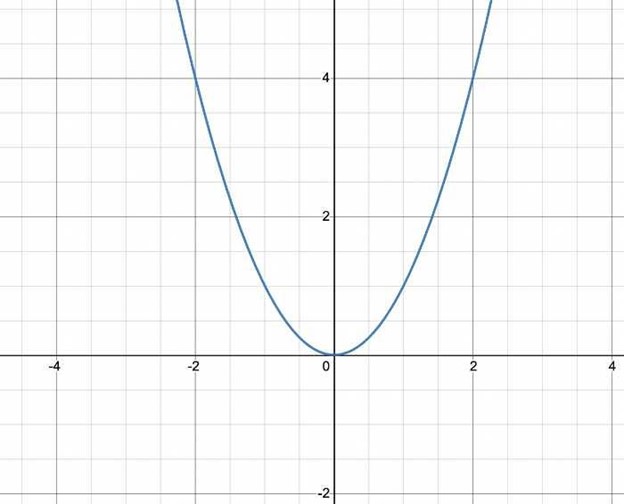One to One Functions - Graph, Examples | Horizontal Line Test
What is a One to One Function?
A one-to-one function is a mathematical function in which each input correlates to only one output. That is to say, for each x, there is only one y and vice versa. This implies that the graph of a one-to-one function will never intersect.
The input value in a one-to-one function is the domain of the function, and the output value is the range of the function.
Let's examine the examples below:

For f(x), any value in the left circle correlates to a unique value in the right circle. Similarly, each value on the right side corresponds to a unique value on the left side. In mathematical jargon, this signifies every domain owns a unique range, and every range owns a unique domain. Thus, this is an example of a one-to-one function.
Here are some more representations of one-to-one functions:
-
f(x) = x + 1
-
f(x) = 2x
Now let's examine the second picture, which displays the values for g(x).
Be aware of the fact that the inputs in the left circle (domain) do not have unique outputs in the right circle (range). Case in point, the inputs -2 and 2 have identical output, i.e., 4. In conjunction, the inputs -4 and 4 have identical output, i.e., 16. We can comprehend that there are equivalent Y values for many X values. Thus, this is not a one-to-one function.
Here are additional representations of non one-to-one functions:
-
f(x) = x^2
-
f(x)=(x+2)^2
What are the properties of One to One Functions?
One-to-one functions have these qualities:
-
The function holds an inverse.
-
The graph of the function is a line that does not intersect itself.
-
It passes the horizontal line test.
-
The graph of a function and its inverse are identical concerning the line y = x.
How to Graph a One to One Function
To graph a one-to-one function, you are required to determine the domain and range for the function. Let's look at a simple example of a function f(x) = x + 1.

Immediately after you possess the domain and the range for the function, you need to plot the domain values on the X-axis and range values on the Y-axis.
How can you determine if a Function is One to One?
To prove whether a function is one-to-one, we can apply the horizontal line test. Once you chart the graph of a function, draw horizontal lines over the graph. In the event that a horizontal line intersects the graph of the function at more than one point, then the function is not one-to-one.
Because the graph of every linear function is a straight line, and a horizontal line will not intersect the graph at more than one spot, we can also deduct all linear functions are one-to-one functions. Keep in mind that we do not leverage the vertical line test for one-to-one functions.
Let's look at the graph for f(x) = x + 1. Once you plot the values to x-coordinates and y-coordinates, you need to consider if a horizontal line intersects the graph at more than one place. In this case, the graph does not intersect any horizontal line more than once. This means that the function is a one-to-one function.

On the contrary, if the function is not a one-to-one function, it will intersect the same horizontal line multiple times. Let's examine the graph for the f(y) = y^2. Here are the domain and the range values for the function:

Here is the graph for the function:

In this case, the graph intersects multiple horizontal lines. Case in point, for both domains -1 and 1, the range is 1. In the same manner, for either -2 and 2, the range is 4. This signifies that f(x) = x^2 is not a one-to-one function.
What is the inverse of a One-to-One Function?
As a one-to-one function has a single input value for each output value, the inverse of a one-to-one function also happens to be a one-to-one function. The opposite of the function basically reverses the function.
For example, in the event of f(x) = x + 1, we add 1 to each value of x for the purpose of getting the output, in other words, y. The opposite of this function will subtract 1 from each value of y.
The inverse of the function is denoted as f−1.
What are the qualities of the inverse of a One to One Function?
The properties of an inverse one-to-one function are no different than every other one-to-one functions. This implies that the inverse of a one-to-one function will have one domain for every range and pass the horizontal line test.
How do you figure out the inverse of a One-to-One Function?
Determining the inverse of a function is not difficult. You just have to switch the x and y values. Case in point, the inverse of the function f(x) = x + 5 is f-1(x) = x - 5.

As we discussed previously, the inverse of a one-to-one function reverses the function. Since the original output value showed us we needed to add 5 to each input value, the new output value will require us to delete 5 from each input value.
One to One Function Practice Examples
Examine the subsequent functions:
-
f(x) = x + 1
-
f(x) = 2x
-
f(x) = x2
-
f(x) = 3x - 2
-
f(x) = |x|
-
g(x) = 2x + 1
-
h(x) = x/2 - 1
-
j(x) = √x
-
k(x) = (x + 2)/(x - 2)
-
l(x) = 3√x
-
m(x) = 5 - x
For every function:
1. Determine whether the function is one-to-one.
2. Plot the function and its inverse.
3. Figure out the inverse of the function algebraically.
4. State the domain and range of both the function and its inverse.
5. Apply the inverse to solve for x in each formula.
Grade Potential Can Help You Learn You Functions
If you find yourself having problems trying to learn one-to-one functions or similar topics, Grade Potential can put you in contact with a one on one tutor who can support you. Our Dallas math tutors are skilled professionals who help students just like you enhance their skills of these concepts.
With Grade Potential, you can learn at your own pace from the convenience of your own home. Plan an appointment with Grade Potential today by calling (214) 307-6375 to learn more about our teaching services. One of our team members will call you to better ask about your requirements to set you up with the best teacher for you!




